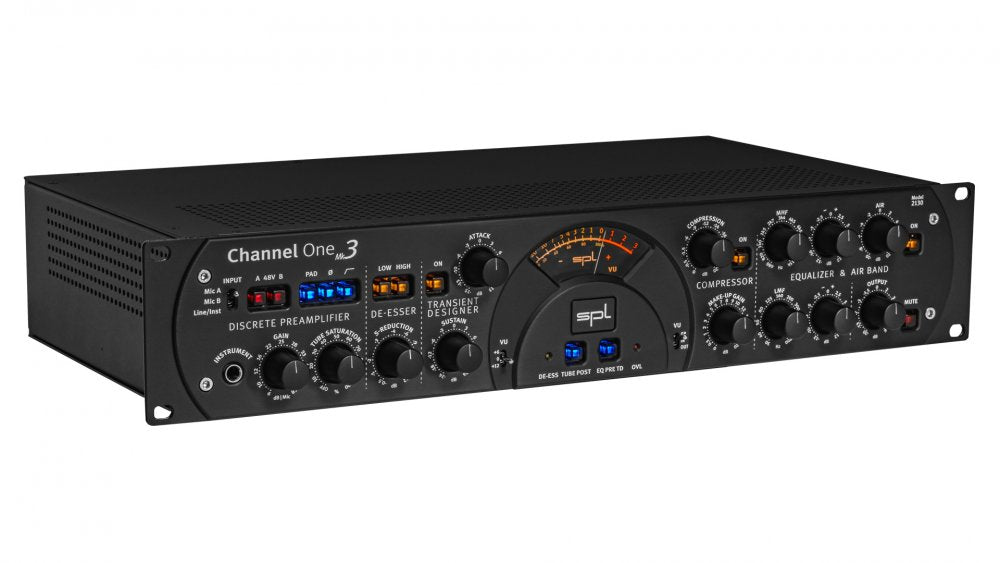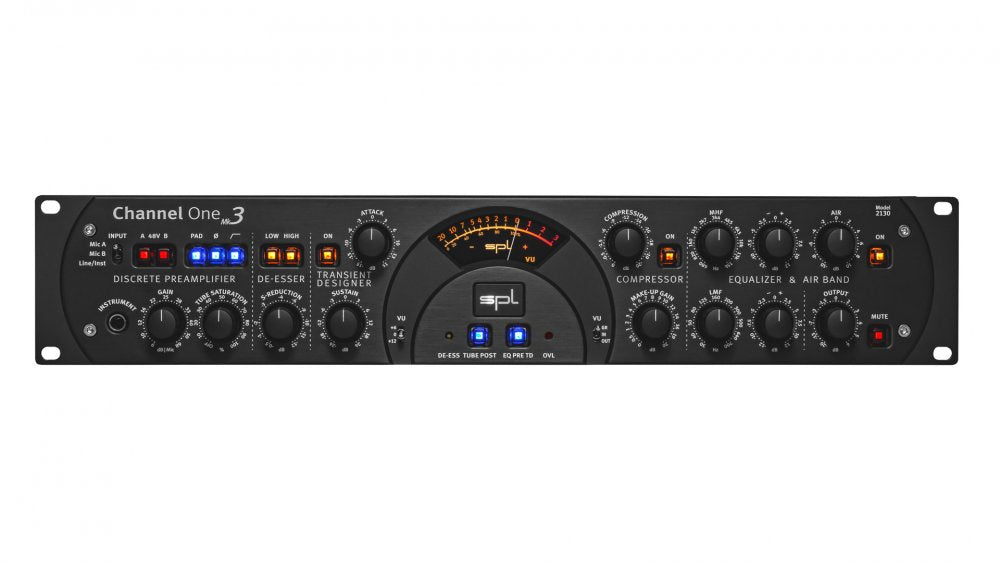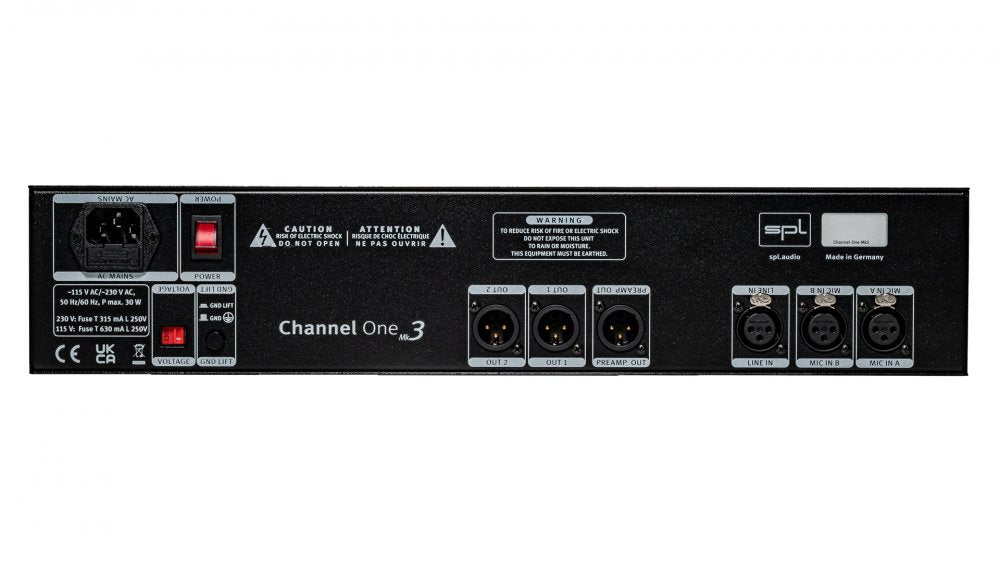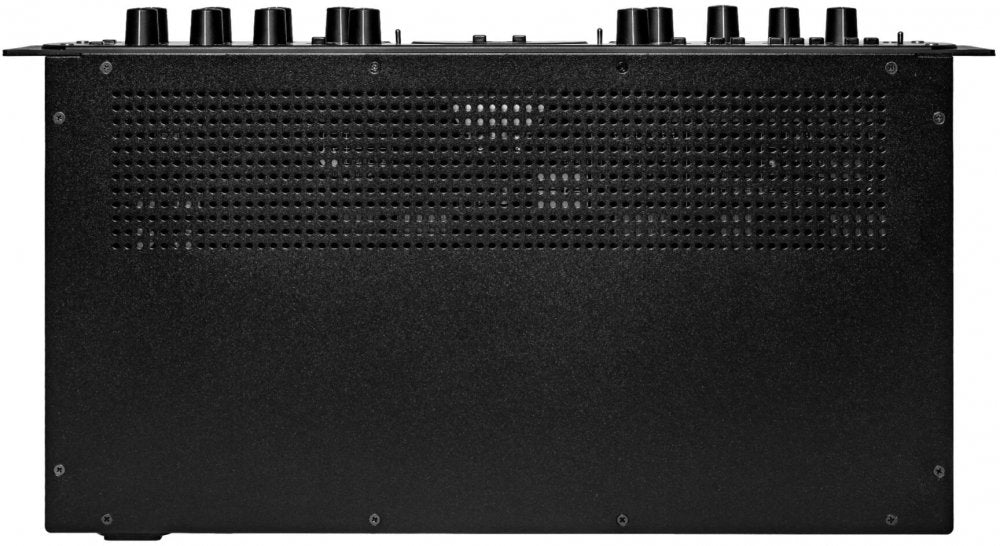Channel One Mk3
Delivery & Shipping
Delivery & Shipping
Free Shipping in Canada with orders over $200. Conditions apply. View details here.
Financing
Financing
Affirm
Break your purchase into easy monthly payments, quick approval and no hidden fees.
Click here for more info.
Equilease
Ideal for larger purchases, Equilease offers customized leasing solutions to fit your business needs.
Click here for more info.
Returns & Policy
Returns & Policy
You can review our terms and conditions here
Description
Description
The perfect front-end for the modern producer. For over 20 years, Channel One has been a synonym for a high-quality and extremely musical recording and mixing channel strip.
In the newest Mk3 version, this classic has been thoroughly revised and, in addition to a higher internal audio voltage (now +/- 18V) for even better, more detailed sound, a further improved preamplifier section, an integrated Transient Designer, a Tube Saturation stage and a Mic A/B comparison option for two microphones and other great features that raise the modern recording and mixing studio to a new level of quality. With de-esser, compressor and equalizer, all the important tools of a real channel strip are still on board. Whether it's a microphone, line, or instrument signal, the Channel One Mk3 makes any source sound like a professionally recorded signal.
The new design of the SPL Studio Series perfectly highlights the sonic qualities of this 3rd generation Channel One.
Discrete Preamplifier Channel One Mk3 is equipped with one discrete preamplifier.
Gain The gain control can be used to adjust the preamplification. For microphone signals, a preamplification of up to 68 dB can be realized - so even really demanding microphones can show their qualities. The control range for line signals ranges between -20 dB and +16 dB. The control range for instrument signals ranges between -6 dB and +30 dB.
Comparing two microphones No problem! Channel One Mk3 offers two microphone inputs on the rear panel - Mic A and Mic B. Two microphones can be connected. This enormously simplifies the workflow. Thus, when comparing or changing microphones, it is no longer necessary to unplug them.
48V The 48V switch activates the phantom power of 48 volts required for the use of condenser microphones. Phantom power can be activated individually for both microphone inputs!
Preamp Out - the direct way to reach your goal The Preamp Out picks up the signal directly after the microphone amplifier. This signal can also be recorded on a separate track in the DAW, for example, to be on the safe side. If it is noticed after a recording session that the singer was a little louder in the perfect take and therefore hits the compressor too hard, this incorrect setting can still be changed afterwards.
The signal recorded for safety can later be played back into the Channel One Mk3 via the Line In and be processed there with Tube Saturation, Compressor or other tools.
Analog plugin Channel One Mk3 offers the possibility to process line signals. This means that sources with line level, such as an analog signal from an audio interface, can be processed with de-esser, compressor, limiter and equalizer and then be recorded again. In this way, Channel One Mk3 becomes an "analog plugin" within an insert of a DAW.
Instrument input The low-noise instrument input is located easily accessible on the front.
PAD The PAD switch attenuates the signal of the microphone input by 20 dB, so that even very high levels can be processed with the Channel One Mk3. This is the case, for example, with loud percussion or brass recordings.
ø The phase reverse function reverses the polarity of the signal. After pressing the switch, the phase is reversed by 180.
Tip: We recommend checking the correct polarity before recording and correcting it if necessary. The phase inversion function can be used, for example, to correct a headphone monitor signal that may be out of phase. A voiceover artist, for example, hears himself through the headphones and simultaneously through the bones in his head. Phase inversion will cause an unnatural sound, and even minimal variations in distance to the microphone will cause drastic variations in the sound. Phase inversion can be applied to the microphone, line and instrument inputs. In general, you can always just try out whether a phase reverse has a positive effect on certain signals in the mix.
Highpass filter A highpass filter with 6 dB per octave reduces impact noise below 80 Hz. This filter can be used for both preamplifiers.
Tube Saturation - magical tube sound With this control the amount of tube saturation can be determined. The output level is accommodated automatically, in extreme settings the level increases by only 6 dB. Therefore decent to expressive harmonic distortions can be easily dialed in by turning just one knob.
Saturation effects are generated through the tube being pushed to and beyond its normal operating limits. In contrast to semiconductors, a tube thus pushed to such levels does not clip from a certain level, approaching more gradually its level limits and thereby producing its typical tonal result, which in audio signal processing can have such often profitable aural effects - on one hand (and depending on the amount applied), from subtle to extensive harmonic distortion and on the other hand, a compaction of the sonic event, that is, a limiting effect that exhibits a pleasant, rounded or soft sound. Acoustically and also in its range of applications this can be compared very well with tape saturation effects.
Tube Post The Tube Post switch changes the order of the Tube Saturation within the signal flow: When the switch is pressed, the Tube Saturation stage comes after the EQ stage and before the output stage; when the switch is not pressed, the Tube Saturation stage comes directly after the preamp and before the de-esser.
De-Esser Unobtrusively and effectively, the Auto-Dynamic De-Esser removes distracting S-sounds, in a mix or on vocal tracks, by detecting only the "S-frequencies", mixing them back into the main signal phase-inverted, and thus simply deleting sibilants in the original signal. The Auto-Threshold control maintains constant processing even as the singer's distance from the microphone varies. The result is tonally neutral, unobtrusive and extremely effective. Even at high S-reduction values, the de-essing has no significant effect on the character and timbre of the voice.
How does the SPL Auto Dynamic De-esser work SPL De-Esser use a unique technology to reduce sibiliance in a mix or on vocal tracks. In contrast to common de-essers based upon compressor techniques the SPL De-Esser makes use of the phase cancellation principle. It employs filters that process only the reducible "S-frequencies" but do not interfere with the remainder of the spectrum. The S-frequencies are detected automatically, the phase is inverted and mixed with the original signal.
This method of operation has distinct advantages because it is unobtrusive and helps retain the original tonal quality.
The reduction is accomplished by comparing the average level with the individual S-sounds: the de-esser functions only when the S-noise level exceeds the average level of the entire frequency spectrum. This means for example that original S-sounds with a certain S-portion are not processed whereas those that are too loud, or do not effectively contribute to the sound, are reduced - but the character of the voice remains unchanged.
A further specialty is the integrated Auto Threshold function which makes processing independent of the input level. Even when the speaker or singer does not maintain a constant distance to the microphone, processing is retained at the pre-set S-reduction value. Conventional systems are dependent on the input level and work more intensively as the distance to the microphone is reduced.
As a result, the SPL De-Esser does not need to be monitored and re-adjusted permanently to keep processing constant - and it can always be applied before the compressor, as changing its position would not be an advantage. That is why an accordant switching function is not necessary.
The result is a sound-neutral, inconspicuous and extremely effective process. Even at high S-Reduction values the de-essing has an egligible effect on the character and timbre of the voice.
S-Reduction The S-Reduction control adjusts the intensity of the S-sound reduction. In practice, S-Reduction settings between -2 dB and -8 dB achieve the best results for most applications.
Low & High The Low and High switches can be used to activate or deactivate the low or high band de-esser, meaning a different center frequency for the de-esser. If no switch is pressed, the de-esser is not active. If the Low switch is pressed, the low de-esser band is activated with a center frequency of 6.4 kHz and a bandwidth of 4.4 kHz. If the High switch is pressed, the high de-essing band with a center frequency of 11.2 kHz and a bandwidth of 5.5 kHz is activated. If both switches are pressed, Low and High band de-esser are active.
SPL Transient Designer - the revolution in dynamics processing. With the Transient Designer it is possible to manipulate the envelopes of audio signals level-independently (no threshold!). Accelerate or slow down transients, lengthen or shorten sustain times " with just two controls: attack and sustain. All time constants are automated in a musical way and optimize themselves adaptively according to the characteristics of the input signal.
The On switch activates the Transient Designer section, consisting of the Attack control and the Sustain control.
Attack Attack can be used to increase or attenuate the transient phase of a signal by up to 15 dB. A positive attack value increases the amplitude of the transient response. Negative attack values lead to an attenuation.
Sustain Sustain can be used to increase or attenuate the sustain phase of a signal by up to 24 dB. Positive sustain values extend the sustain. Negative Sustain values shorten the sustain.
Specifications
Specifications
Payment & Security
Your payment information is processed securely. We do not store credit card details nor have access to your credit card information.








